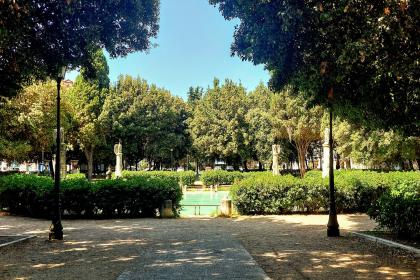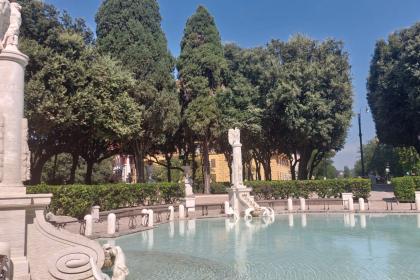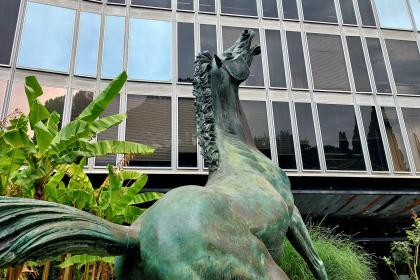
Melancholy and beauty between ancient and modern
A fragment of a hieratic and melancholic female face, seemingly unfinished like an archaeological legacy. A total of 10 meters high and perfectly “tuned” between past and present, the monumental fountain of the Goddess Roma was created in 2003 on behalf of the Leonardo Group (at the time Finmeccanica), the industrial holding company active in the defense, aerospace and security sectors. The sculpture, later donated to the city of Rome, is located in a small green area a few steps from the company’s registered office, a modern glass and concrete building in the Quartiere della Vittoria, in a square overlooking the Tiber. It is an evocative setting, despite the traffic on the Lungotevere, thanks also to the hedges and trees surrounding the sculpture: holm oaks, cypresses, pines and olive trees in memory of the sacred forest of the legend about the founding of Rome.
Flowing history
Drawn in the context of the 1911 World’s Fair, the Quartiere della Vittoria district bears witness with its buildings and elements of urban decoration (for example, the fountain in the gardens of Piazza Mazzini or Francesco Messina’s imposing bronze horse) to the evolution and history of Roman architecture and art over a century. The visible cracks in the stone and water of the large fountain are meant to allude precisely to the flow of time, memories and History (with a capital H), a theme dear to its author, sculptor (Polish by birth and French by adoption) Igor Mitoraj. The water pipe that should line the face of the goddess is now generally closed but the sculpture, resting like an ancient ruin on fake rocks in the center of a low triangular basin, deserves our full attention and seems to have always inhabited the spot where it was placed.
A tribute to Rome
In his own style, the work is a visual homage to Rome, “a kind of act of love”, the artist recounted, toward an incomparable city “that lives on in the universal imagination”. Fond of classical art and known for his monumental sculptures that reinterpret ancient figurative canons in a personal and contemporary key, Mitoraj has exhibited and traveled all over the world but has forged a special relationship with Italy. Rome, the city that hosted him and influenced his figurative repertoire and where he also bequeathed the magnificent head of St. John the Baptist and the bronze doors of the Basilica of Santa Maria degli Angeli, is a perfect backdrop for his works, which seem to find a perfect match and possess a particular expressive force here. Also a tribute to the city is the material used for Goddess Rome: the Tivoli travertine we find in Bernini’s masterpieces, monuments, ancient palaces, and bridges.
Igor Mitoraj (1944-2014)
Fontana della Dea Roma (Fountain of the Goddess Roma), 2003
Piazza Monta Grappa
Photo turismoroma
© Riproduzione riservata
Gardens in Piazza Mazzini

 Condividi
Condividi
Fountain in Piazza Mazzini

 Condividi
Condividi
The bronze horse of Viale Mazzini












































